Serbian disaster. Battle of Kosovo field
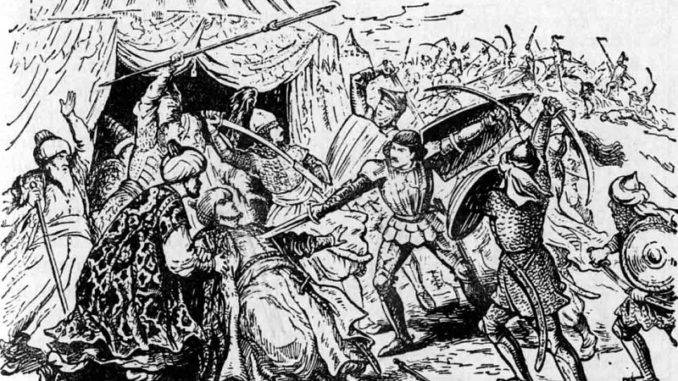
The beginning of the Ottoman invasion of the Balkans
Ottoman Turks began expansion into the Balkans before the fall of the Byzantine Empire. As the main centers of Byzantium were captured, the Turks launched an invasion of the Balkan Peninsula. In 1330, the Turks took Nicaea, in 1337 - Nicomedia. As a result, the Turks took possession of almost all the lands north of the Gulf of Izmit up to the Bosphorus. Izmit (as the Ottomans called Nicomedia) became the base of the nascent Ottoman fleet. The Turks' access to the shores of the Sea of Marmara and the Bosphorus opened the way for them to raids into Thrace (historical region in the east of the Balkans). Already in 1338, the Ottoman forces began to ravage the Thracian lands.
In 1352, the Ottomans inflicted a series of defeats on the Greek, Serbian, and Bulgarian units that fought for the Byzantine emperor. In 1354, the Ottomans effortlessly captured the city of Gallipoli (Turkish Gelibol), whose walls were destroyed by an earthquake. In 1356, the Ottoman army under the command of the son of Orhan, the ruler of Oman, Beylik, Suleiman, forced the Dardanelles. Having seized several cities, the Turks launched an offensive against Adrianople (Tour. Edirne). However, in 1357, Suleiman died before he could complete the campaign.
Soon the Turkish offensive in the Balkans was renewed by another son of Orhan, Murad. The Turks took Adrianople after the death of Orhan, when Murad became the ruler. This happened, according to various sources, between 1361 and 1363. The capture of Adrianople was not accompanied by a long siege. The Turks defeated the Byzantine troops on the outskirts of the city and he was left without a garrison. In 1365, Murad moved his residence from Bursa for a while. Adrianople became a strategic base of the Turks for further offensive in the Balkans.
Murad took the title of Sultan, and in his reign, the Ottoman Beylik was finally transformed (and his son Bayezid) into a vast and militarily strong state. During the conquests, a system of land distribution was given to those close to and soldiers for service. These awards were called Timar. It became a type of military-military system and the main social structure of the Ottoman state. When fulfilling certain military obligations, the Timar holders, the Timarions, could transfer them to their heirs. The sultans received military and social-political support in the face of the noble Timarions.
Military seizures became the first and main source of income of the Ottoman state. From the time of Murad, the transfer to the treasury of the fifth part of military production, including prisoners, became law. Tribute from the conquered peoples, cities and military booty constantly replenished the sultan's treasury, and the production of the population of the conquered areas gradually began to enrich the Ottoman nobility - dignitaries, military leaders, clergy and bey.
There is a system of management of the Ottoman state. Under Murad, various affairs were discussed by the Viziers (Vazirs) - by the ministers, from among them stood the Grand Vizier, who was in charge of all affairs, military and civilian. The institution of the great vizier for centuries became the central figure of the Ottoman administration. Common affairs as the highest advisory body was in charge of the Sultan Council. An administrative division appeared - the state was divided into sandjaks (translated as “banner”). They were led by Sandjak Bei, who had civil and military power. The judicial system was entirely in the hands of the ulama (theologians).
In the Ottoman state, which expanded and developed as a result of military conquests, the army had priority. Under Murad there existed cavalry on the basis of feudal-Timarions and infantry from peasant militias. Militiamen were recruited only during the war and during this period they received a salary, in peacetime they lived at the expense of cultivating their lands, having tax relief. Under Murad, a janissary corps was formed (from “Yeni Cheri” - “New Army”), which later became the striking force of the Turkish army and the Sultan's Guard. The corps was completed by the forced recruitment of boys from families of subdued peoples. They were converted to Islam and trained in a special military school. Janissaries submitted to the Sultan personally and received a salary from the treasury. Somewhat later, the Janissaries' corps were formed by cavalry detachments, which were also on the sultan's salary. The Ottomans were also able to create a strong fleet. Everything provided steady military successes of the Ottoman state.
Thus, by the middle of the XIV century, the core of the future great power had formed, which was destined to become one of the largest empires in the history of mankind, a powerful naval power, which in a short time subjugated many peoples of Asia and Europe. The expansion of the Ottomans was facilitated by the fact that the main opponents of the Turks - Byzantium, the Serbs and Bulgarians were in decline, were at enmity with each other. The Balkan Slavic states were fragmented, and the Ottomans could successfully act on the principle of "divide and conquer." Venice and Genoa were not concerned with the expansion of the Turks, but with their struggle for monopoly trade in the east. Rome tried to use the situation to force Constantinople, the Greek church to bow under the authority of the pope.
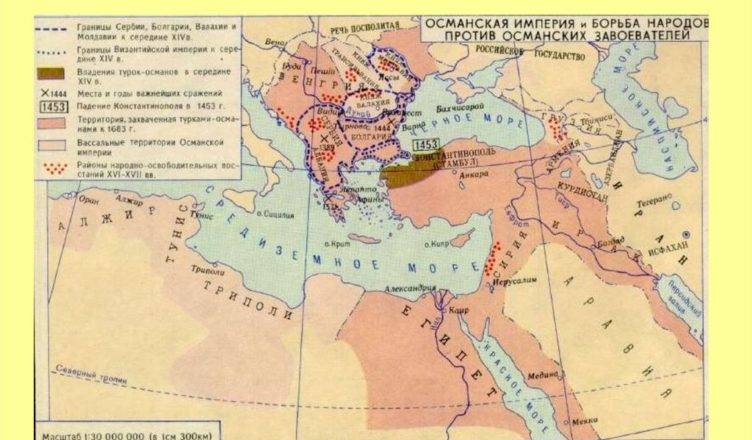
Conquest of the Balkans
At the turn of 50 — 60-s of the XIV century. the offensive of the Ottoman Turks in the Balkan Peninsula was temporarily suspended by the struggle for power within the Ottoman dynasty and the exacerbation of relations with neighboring beylik states in Asia Minor. Therefore, in 1366, Amadeus of Savoy (uncle of the Byzantine emperor of that time) beat off the Gallipoli peninsula from the Ottomans, which made it difficult for the Turks to connect European and Asian territories.
Once Murad figured out with rivals, eliminating the brothers Ibrahim and Khalil, he was able to continue the conquest. He defeated the beys of the neighboring Turkic Beyliks who tried to challenge the Ottomans domination in Asia Minor. Murad's campaign against the Karaman bey ended with the capture of Ankara. As a result, the possession of Murad increased significantly due to the district of Ankara.
Having established relative order in the rear and in the east, Murad again turned his troops to the west. He quickly returned the previously lost lands in Thrace. The Turks seized the large and rich Bulgarian city of Philippopol (Plovdiv). The Bulgarian king Shishman became a tributary of the Turkish Sultan and gave his sister to the harem of Murad. The capital of the Ottoman state was moved to Adrianople-Edirne. The Turks in September 1371 crushed the Serbs in the battle of Maritz. The Turks were able to take the enemy by surprise and arrange a slaughter. The brothers Mrnyavchevichi, the king of Prilep Vukashin and the despot of Ceres Uglesh, who led the resistance to the Ottoman invasion, were killed. Their sons became vassals of Murad. The conquest of Macedonia begins, many Serbian, Bulgarian and Greek major feudal lords become vassals of the Ottoman sultan. Since that time, the vassal Serb units began to fight on the side of the Sultan in his wars in Asia Minor.
However, the offensive impulse of the Ottomans in the Balkans was again suspended by internal strife. The son of Murad, Savji, in 1373, raised a rebellion against the Sultan. He made an alliance with the heir of the Byzantine throne, Andronicus, who challenged the power of his father, Basileus John V. Savdji, while his father was in Europe, raised a revolt in Bursa and declared himself Sultan. The rebellious princes seized Constantinople and displaced John, Andronicus declared himself emperor. Murad personally led the army to quell the rebellion. The princes were defeated, the Greeks fled to Constantinople. Savji was besieged in one of the fortresses and soon capitulated. He was tortured, gouged out, and then cut off his head. John with the help of the Sultan's troops returned Constantinople. Murad ordered to throw off the Greek accomplices of Savdji from the fortress wall, and the Byzantine emperor had to blind his son under the pressure of the Sultan. The power of the Byzantine emperor at that time was so weak that he was de facto a tributary of the Sultan. The emperor's daughters replenished the harem of Murad and his sons.
True, the recalcitrant prince did not calm down, and soon, with the help of Murad and Genoa, he overthrew his father again. The sultan was angry that John agreed to sell the island of Tenedos to Venice, which led to the union of Genoa with the Ottomans. As a payment for help, Andronicus gave the island of Tenedos to the Genoese, and Gallipoli to the Turks. As a result, the Ottomans strengthened their position in the strait zone and the link between their European and Asian territories. In 1379, the sultan again decided to use John, freed him and put him on the throne again. As a result, Byzantium became a vassal of the Ottoman Sultan. Turkish troops captured Thessaloniki and other Byzantine possessions in the Balkans. Constantinople was waiting for the capture at any time.
Meanwhile, Murad’s forces were again diverted to the east. While the Ottomans were advancing in the Balkans, beat Karaman Alaeddin expanded his possessions in Asia Minor. Karamansky Bey began to challenge the acquisition of land from Hamidides by Murad, who sold their possessions to the sultan. Alaeddin himself claimed these possessions. The leader of Karaman considered that the time for war was favorable. Murad's army in the Balkans, and weakened by the recent civil strife. Alaaddin launched an offensive and seized a number of possessions. However, Murad demonstrated success in military construction and was able to quickly transfer troops to another front in Asia Minor. In 1386, the Sultan army utterly defeated the Bey troops on the Koni plain. Sultan's standing troops showed an advantage over the feudal militia of the Karaman bey. Murad laid siege to Konya, and Alaeddin asked for peace. The Ottomans expanded their possessions in Anatolia.
Turkish offensive
Murad returned with an army in the Balkans. By this time, individual Turkish troops had already invaded Epirus and Albania. The Serbs, defeated by the Turks in 1382, were forced to admit their dependent position and signed peace, promised to provide their soldiers to the Sultan. However, the Turks were preparing for a new offensive, while the Serbs were addicted. Soon the Ottomans invaded Bulgaria and Serbia, captured Sofia and Niš. Bulgarian king Shishman surrendered to the mercy of the winners, became a vassal of the sultan.
Resistance to the Ottoman invasion in the Balkans was led by the Serbian prince Lazar Khrebeljanovic and the king of Bosnia Tvrtko I Kotromanich. Lazar, under the threat of a Turkish attack, was able to unite the northern and central regions of Serbia, trying to rally the large feudal lords, to stop their strife. He was able for some time to strengthen the internal position of Serbia. Lazar beat off the Machuva and Belgrade regions from the Hungarians. Tvrtko I got rid of dependence on Hungary, defeated his rivals and was in 1377, took the title of King of the Serbs, Bosnia and the coast. In the 1386 year (according to other data in the period 1387 - 1388), the Serbian army, commanded by Lazarus and Miloš Obilic, with the support of the Bosnians, routed Turkish troops under the command of Шахahin bey in the battle of Pločnik in southern Serbia. The Serbs were able to take the enemy by surprise, the Ottomans, not finding the enemy, began to disperse to plunder the environs. As a result, the Serbian heavy and light cavalry destroyed most of the Turkish army. This victory temporarily slowed down the advance of the Ottomans in Serbia. In August, Bosnians, under the leadership of Governor Vlatko Vukovich, defeated the Ottomans under the command of Шахahin Pasha in the Battle of Bilec in August, temporarily stopping Turkish raids on Bosnia.
In June 1389 of the year, Sultan Murad led a large army (30 - 40 Thousands of Warriors) on Serbian lands. The Turkish army consisted of several thousand janissaries, the Sultan's horse guards, 6 thousand sipahs (heavy regular cavalry), up to 20 thousand infantry and light irregular cavalry, and several thousand soldiers from vassal rulers. A special feature of the Turkish army was the presence of firearms. weapons - guns and muskets. Under Sultan there were his sons Bayazid (he was already noted as an outstanding commander) and Yakub, the best Turkish commanders - Evrenos, Shahin, Ali Pasha and others. Having passed through the difficult Ikhtiman gorge, the Turks came to the Morava River, forced it and 14 of June occupied positions on the Kosovo field. It was a plain on the border of Bosnia, Serbia and Albania, it was also called the Drozd Valley.
The Slavic army came out to meet the enemy, the main forces of which consisted of Serbs and Bosnians. She, according to various sources, numbered from 15 to 30 thousand soldiers. Half of the army consisted of the warriors of Lazar, the rest of the troops were set up by the ruler of lands in Kosovo (Vukova land) and Northern Macedonia Vuk Brankovich and Bosnian voivode Vlatko Vukovich, sent by King Tvrtko. With the Bosnians came a small detachment of Knights Hospitallers. Also on the side of the Serbs were small detachments of Albanians, Poles, Hungarians, Bulgarians and Vlachs. The weakness of the Serbian army was the lack of a single command - the three units of the troops had their own commanders. Prince Lazar himself commanded the center of the Slavic army, Vuk Brankovich commanded the right wing, Vlatko Vukovich commanded the left. Also, the Serbs and the Bosnians were dominated by heavy cavalry, there was little infantry. That is, with the first failure of the cavalry, she could not retreat to the positions of the infantry, and under her cover to rest, regroup and go over to a new offensive.
Battle on the Kosovo field and its consequences
On the eve of the battle, June 14, military councils were held in both camps, Ottoman and Serbian. Some Turkish commanders offered to bring camel riders to the front in order to cause confusion among the enemy. However, Bayazid opposed, since such cunning meant disbelief in the army and camels during the attack of the Serbian heavy cavalry could upset the ranks of the Ottoman army itself. He was supported in this issue by the Grand Vizier Ali Pasha. At the advice of the Allied Slavs, it was proposed to start the battle at night. However, the prevailing view was that there was enough strength to win the day. Also, the allies quarreled - Vuk Brankovich accused of treason Milos Obilic.
The Turks were commanded by Eurenos and Bayazid in the right wing, Yakub commanded the left, the sultan himself was in the center. There is no exact picture of the battle. It is known that the battle began with a shootout of archers. Then the heavy Serbian cavalry launched an offensive on all fronts. The Serbs were able to break through the left flank of the Ottoman army under the command of Yakub, the Turks pressed. Here the Turks suffered heavy losses. In the center and on the right flank the Ottomans resisted. Although the center of the troops of Lazarus also oppressed the enemy. Then the Serbian heavy cavalry lost the shock capabilities, bogged down in the defense of the enemy. Turkish infantry and cavalry began to go on the offensive, pushing up the frustrated ranks of the enemy. On the right wing, Bayazid struck a counterblow, pushed the Serb cavalry back and hit their weak infantry. The positions of the Serbian infantry were broken, she ran.
Vuk Brankovich, trying to save his troops, left the battlefield. He led his squad over the river. Sitnica. Later, the people cursed Vuk Brankovich, accusing him of treason. Bosnians, attacked by Bayazid, ran after him. The Serbian army was crushed. Prince Lazar was captured and executed.
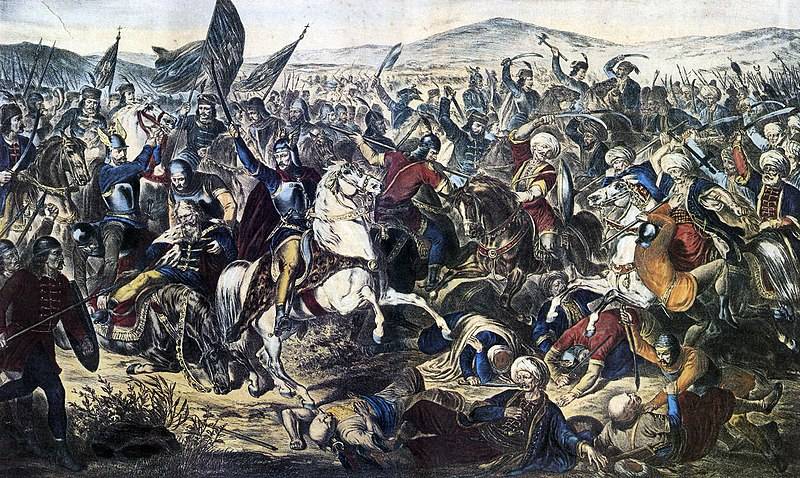
It is interesting that during the battle an unusual situation arose in the camp of the Turkish army. Sultan Murad was killed there. There is no exact information about this event. According to one information, at the beginning of the battle, a Serb defector named Miloš Obilic was brought to him. He promised to tell important information about the Slavic army. When Milos was brought to Murad, he killed the Ottoman ruler with an unexpected blow of a dagger. Serb immediately killed security. According to another version, the sultan was on the battlefield, among the defeated warriors, and an unknown Christian, pretending to be dead, unexpectedly attacked Murad and killed him. Another version reports a group of warriors who, at the height of the battle, broke through the Ottoman ranks and killed Murad.
Whatever it was, the selfless act of the Serbian warrior did not affect the outcome of the battle. The Turks won a complete victory. True, in the leadership of the Ottoman there was a lightning coup. Bayazid immediately during the battle ordered to kill his brother Yakub, in order to avoid the struggle for the throne.
The battle of Kosovo decided the fate of Serbia. Militarily, the victory was not complete. The Ottomans suffered such losses that they could not continue the offensive and retreated. The new Sultan Bayazid did not tempt fate and hurried back to strengthen his position in the state. Vuk Brankovich, the ruler of Kosovo, recognized the power of the sultan only at the beginning of the 1390s. And the Bosnian king Tvrtko announced the victory of Christians. The death of Murad and his son Yakub in battle confirmed his words; victory over the Turks was reported in Byzantium and other Christian countries.
However, in strategic terms, it was the victory of the Ottoman army. After the death of Lazarus, Serbia was no longer able to unite, and to mobilize forces for a new battle, and a long confrontation on its borders. The Ottomans easily survived the heavy losses of the army. Their war machine easily made up for losses and continued expansion. Soon Stefan Lazarevich, the young son and heir of Lazarus, Milica’s mother was regent until his adulthood, he had to admit that he was a vassal of Bayazid. Serbia began to pay tribute with silver, and to provide troops to the Sultan at his first request. Stefan was a loyal vassal of Bayazid and fought for him. Stephen’s sister and Lazarus’s daughter, Oliver, was given to Bayazid’s harem. Until the middle of the XV century, Serbia was a vassal of Turkey, then became one of the provinces of the Ottoman Empire. Bosnia, where after the death of Tvrtko in 1391, his sons unleashed civil strife, also became easy prey for the Turks.
The battle on the Kosovo field made Bayazid the Lightning Master of the Balkans. The Byzantine emperor felt so weak that, in fact, he became a vassal of the sultan. The Byzantines even helped the Ottomans take Fildelphia, located east of Smyrna, the last possession of the Greeks in the western part of Asia Minor. In 1393, the Turks seized the Bulgarian capital Tarnovo. By 1395, the last stronghold of the Bulgarians, Vidin, fell. Bulgaria was conquered by the Turks. Ottoman troops occupied the Peloponnese, the Greek princes became vassals of the sultan. The confrontation between Turkey and Hungary began. Thus, by the end of the century, the Ottomans conquered much of the Balkan Peninsula.
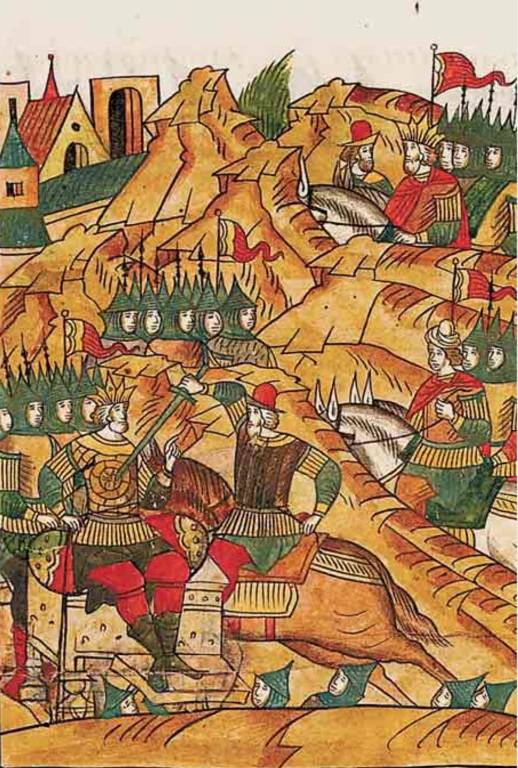
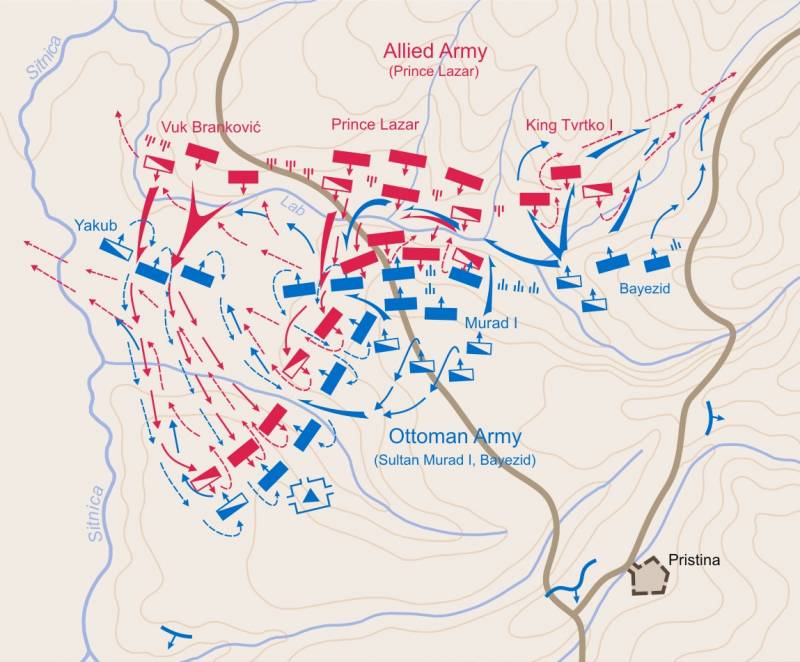
Information